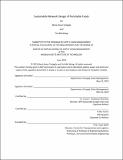| dc.description.abstract | Our project analyzes the trade-offs between costs, service level, inventory strategy, and CO2 emissions in a global food and beverage retailer's current network design. We analyze the network design of a perishable product and evaluate which levers or variables can change (transportation mode, suppliers’ locations, inventory) in their existing network, as well as what variables are constraints and cannot be changed (truck sizes, product specifications, DC locations). We explore how full truckload vs. less-than- truckload transportation impacts their network and consider new supplier locations. We create a network design model in Python that offers the sponsor company various solutions that highlight the trade-offs between costs, service level, and CO2 emissions. Key insights of this project are the following: (1) the company should utilize LTL transportation; (2) there is a cost benefit of adding a third supplier to the network design; (3) if the company wants to achieve a higher service level, the total costs of inventory, transportation, and COGS will be higher in comparison to the total costs of a lower service level; and (4) for each service level, as the cost decreases the total emissions (kg CO2) per week and expected number of expired items also increases. | en_US |
